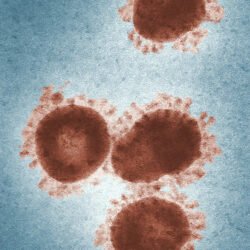How To Kill The Virus & Flatten The Curve
There is plenty of new research coming out telling us everything we need to know about COVID-19; precisely what the virus is, how it spreads, and how it can be broken down.
I want to share some of this information with you today!
A little about the naming of the virus…
All viruses have a name that is different from the disease they cause. For instance, we all know that the HIV virus causes the disease AIDS.
COVID-19 is the name of this new coronavirus disease. COV refers to the word COronaVirus. The number, 19, refers to 2019, the year this virus spread from another species and caused a human pandemic.
SARS-COV-2 is the name of the virus that causes the COVID-19 disease. SARS stands for Severe Acute Respiratory System. The number 2 refers to the fact that this is the second of the SARS outbreaks.
The SARS-COV-2 virus is very large as viruses go which means that most virus particles can be, at least partially, blocked by any type of cloth mask that covers your mouth and nose – not just medical-grade, air-tight masks but any home-made mask.
Medical grade masks are meant to protect those who are getter exposed to high concentrations of air-borne virus particles from close proximity to those who are very ill. But all masks do provide protection. The closer the fit, the more layers of material and the smaller the pore size of the mask, the better they will protect.
Virus Survival on Various Surfaces
Studies have found that the virus survives for the longest time-period on smooth surfaces: metal (5-9days), wood (4-5 days) and plastic (3-5 days).
SARS-Cov-2 can stick onto paper, cardboard and cloth quite easily. The survival rate has varied quite a bit from one study to the next. The range of survival time has varied from 12 hours to 5 days. This may have to do with the temperature of the air and surfaces as well as the amount of sunlight exposure.
In light of this, you must pay extra attention to disinfecting any and all surfaces that you or others touch regularly.
Think
- Door edges and handles
- Handrails
- Doorways and wall corners
- Household appliances
- Bathroom fixtures and all faucets (inside and out)
- Groceries
- Keys
- Packages
- Cell phones
- Credit cards
- TV remotes
And more!
You should assume that any surface that may have been touched by someone has virus particles on it and should be disinfected.
Cleaning anything that you bring into your home is now the new normal!
How Do I Keep Things Clean?
Hard Surfaces
As with washing your hands, you can clean smooth surfaces and products with soap and water – make sure the soap is bubbling, and the water is warm to hot!
However, with certain appliances such as cell phones and keyboards, soap and water might not be appropriate.
In cases like these, you can use 70% isopropyl alcohol (rubbing alcohol), >80% ethyl alcohol (grain alcohol), a store-bought disinfectant, or 10% bleach (One part bleach and nine parts water). With 10% bleach or liquid disinfectant, lightly dampen a paper towel or cloth to swipe your surfaces taking care to not drizzle any liquid where it doesn’t belong.
Cleaning with alcohol is my favourite for electronics because it will dry extremely quickly, so you don’t need to worry about liquid damage!
Fabric
The virus can live in clothing and fabrics for at least 12 hours at room temperature but is completely destroyed by washing with any brand of laundry detergent.
For this reason, it’s safe to wash the clothes of someone who is well with those of someone who is sick because all the clothes are being cleaned completely in the process. Consider washing cloth masks, clothing and bedding that is suspect of contamination on a daily basis.
With items that can’t be washed regularly, direct sunlight can have the same effect as a detergent in breaking down the virus particles. Place jackets, hats, shoes and belts in the sun for at least 2-3 hours, turning (inside out if possible and appropriate) every 15-30 minutes. SARS-COV-2 hates high temperatures, so leaving your clothes out flat in direct sunlight for 2-3 hours on each side will work to breakdown any virus particles that are living in the fabric.
Which brings us to the most important thing to know about COVID-19…
COVID-19 Hates Heat
Research has found the virus to be extremely stable at low temperatures and indefinitely stable at all freezing temperatures. However, this virus can’t stand the heat!
This is why the virus prefers to live in our sinuses, throat and the first surface of our lungs because these are the only areas of our body to which we breathe in cool air which the virus needs to thrive.
The more heat the virus is exposed to, the more unhappy it becomes.
In fact, at 80 degrees Fahrenheit (27 degrees Celsius), the virus will start to break down and at 130 degrees Fahrenheit (57 degrees Celsius), the virus will completely disintegrate in 15 minutes.
So, if you or a loved one is taken ill you should be working to raise your body temperature!
How To Raise Your Body Temperature
You can raise the temperature of your body by:
- Drinking hot liquids frequently like teas, broths or soups. This may be particularly helpful for those who have the initial symptom of a dry or sore throat.
- Get into a hot bath for 20-30 minutes. If you have access, use a sauna heated to 130 degrees Fahrenheit (57 degrees Celsius) for 15 minutes. If you are sick and do not have a high fever, heat the body 2-3 times per day.
- Avoid anti-inflammatory medication or remedies – a fever is your body’s natural way of fighting the virus with high temperature. Try not to interrupt this process unless you are advised to by your doctor.
- Get out into the sun – expose as much bare skin as you can to the sun for as long as you can without any sunburn. This will warm your body, help create vitamin D necessary for proper immune function and will help you to feel happy by supporting normal hormone and neurotransmitter balances.
If you watch the video COVID-19: How to Kill the Virus and Flatten the Curve, you will see a technique described that will increase the temperature of only the respiratory tissues. This has been shown repeatedly to be effective for killing other coronaviruses and is likely to work for SARS-COV-2 virus particles as well.
Please watch the video to see how it works.
Flattening The Curve
It’s important to remember that virus cannot spread without our cooperation. If we adhere to social distancing, we stop the virus spreading and start to flatten the curve.
If the virus can’t find a new host (i.e. another person in which to live), then it has no choice but to die off quicker.
We only need to maintain this behaviour for a relatively short period of time, so we can slow the spread of the virus, allow the people who are sick to get the health care that they need, and allow our healthcare workers to get some sleep every so often. It’s pretty simple.
I believe that the most dangerous pandemic is not COVID-19; the pandemic that is tearing us up is the fear and panic from the uncertainty and loss of control.
But if we pay attention, live by the guidelines we’ve been given and take simple measures to protect ourselves and those around us, then we will survive.
My advice to everyone is to take this time to do the things you never have time to; read that book, make repairs, produce art, write a blog or listen to some great music.
Above all – practice love, laughter and tolerance!
What next?
For far more in-depth information about how to boost the immune system, protect yourself from viral infections and how to manage your health if you have taken ill, take a look at my e-Book VIRUSES! – How to stop respiratory viral infections before you get sick.
I put aside a bit of time each month to help individuals with their questions and concerns. If you have questions or require additional information, don’t hesitate to contact my office for a free, fifteen-minute consultation.
You should also check out the following Dr Sandy audio downloads:







